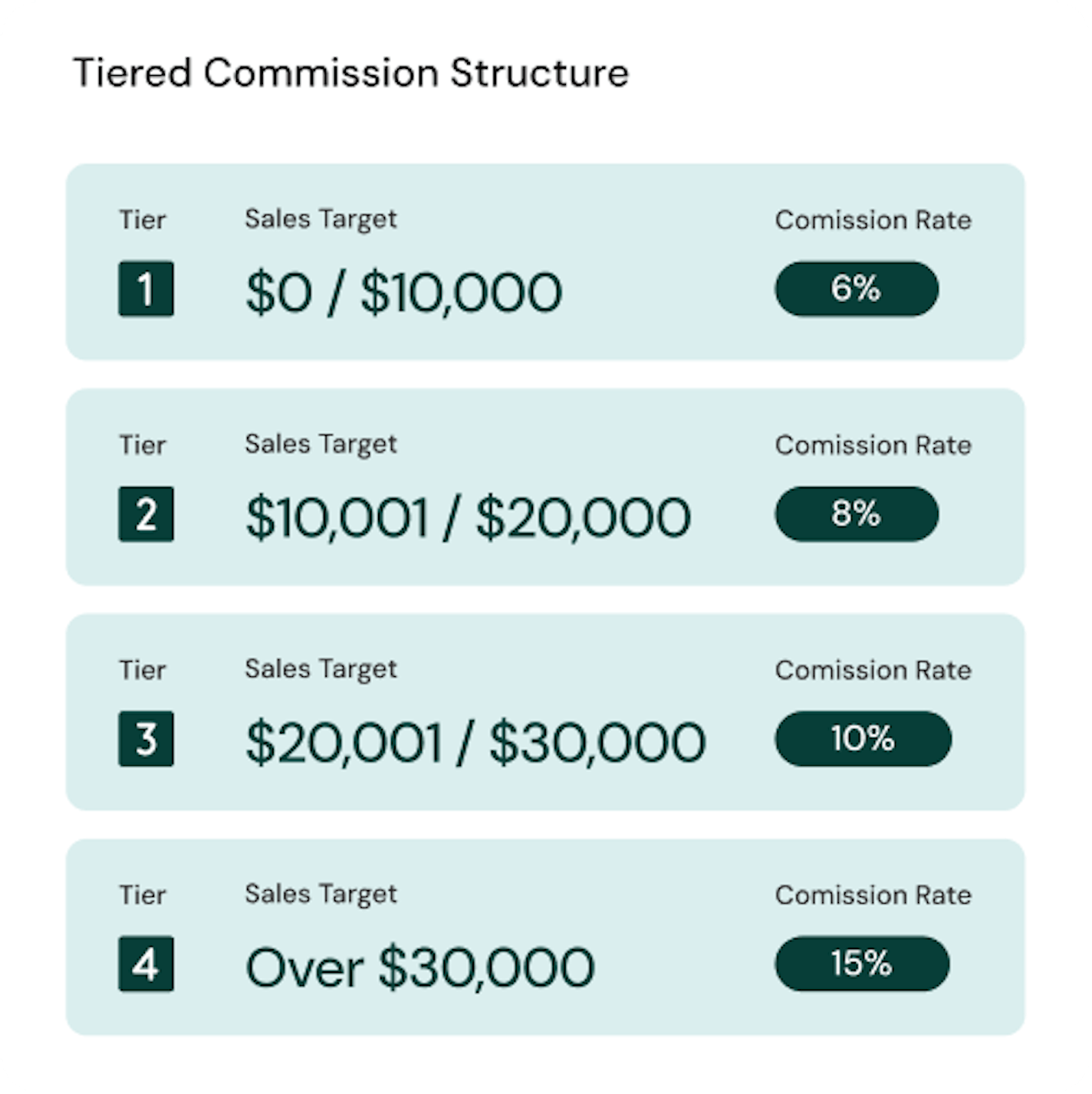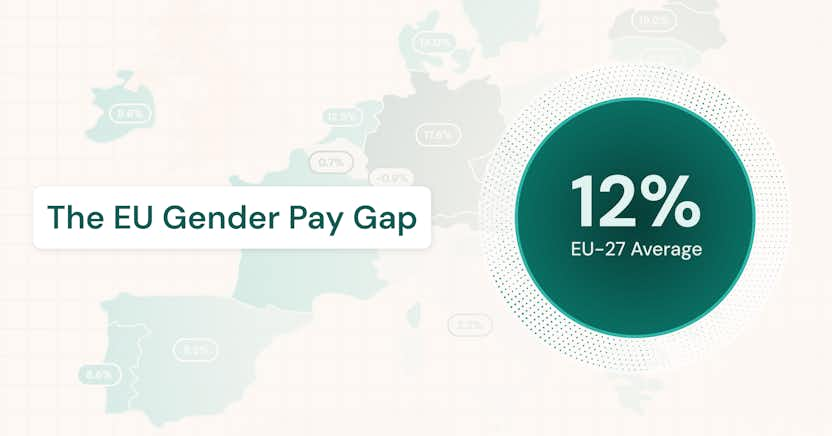Driving Sales With a Tiered Commission Structure

Learn more about the following beqom products
Unlocking the secrets to skyrocketing sales and employee motivation starts with a strategic approach to compensation. Research shows that effectively managing customer satisfaction, employee engagement, and financial performance is a complex puzzle for many businesses. A tiered commission structure can boost sales, enhance employee motivation, and improve overall business performance.
With more than 70% of business leaders being pressured by executives to increase employee productivity and the cost of acquiring new customers being five times higher than retaining existing customers, organizations are in a constant battle to increase revenue while keeping customers and employees happy. Embracing innovative commission structures can provide a strategic solution to these challenges.
What is a tiered commission structure?
A tiered commission structure is a type of commission plan that offers progressively higher commission rates as employees surpass predetermined sales targets and reach daily, weekly, monthly, or quarterly quotas. A tiered commission structure aims to incentivize progressively higher sales performance.
Sales targets can be based on product types, revenue, profit, units, customer type (new or returning), or number of closed deals, among other criteria.
A typical tiered commission structure may resemble the following:

Benefits of tiered commission structures
Organizations aiming to increase employee motivation and drive sales should consider implementing a tiered commission structure. Key benefits of this structure include:
Sales revenue
As sales reps have further incentives to improve their sales techniques and reach targets, they will likely perform better. Enhanced employee performance can increase the organization’s sales revenue, facilitating its sustained growth and elevating its competitiveness.
Employee engagement
When employees have an opportunity to earn more, they are likely to become more invested in their work and committed to their roles. Rather than limiting themselves to fulfilling their basic obligations, sales reps will push themselves, think of creative solutions, and challenge themselves to maximize their earning potential, leading to increased engagement. Achieving goals, such as sales targets, can also improve employees’ confidence levels, driving them to pursue higher levels of performance and productivity.
Organizations can also consider implementing long-term incentive (LTI) programs and combine them with tiered commission structures to further increase employee engagement, motivation, and loyalty.
Employee collaboration
Tiered commission structures, particularly team-based models, can encourage teamwork, improve communication, and increase overall team performance. To reach sales targets, employees may support each other, share tips and best practices, or otherwise collaborate to ensure everyone can succeed. Shared achievement and team success can also enhance employee satisfaction, resulting in a positive, cohesive, and high-performing sales team.
Customer satisfaction
Sales reps who strive to meet sales targets and quotas will be more focused on providing excellent service, which can help to establish long-term relationships with customers. Satisfied customers will be more likely to make additional purchases, leave positive reviews, and recommend the company to others, furthering increasing sales and enhancing the organization’s reputation.
Recruiting and retention
Employing a tiered commission structure provides upside in compensation, which is motivating to salespeople and provides the opportunity for them to maximize their earnings. This ensures that top-performing employees are well rewarded for their efforts, which in turn promotes loyalty and offers a competitive advantage in recruiting top sales talent.
Types of tiered commission structures
Various tiered commission structures can motivate employees differently and alter how they approach their roles, so organizations must carefully decide which structure’s outcomes best align with their specific goals and objectives.
- Product-based: Products are assigned different commission rates, with those that are more complex to sell or have higher profit margins granting greater commission rates.
- Revenue-based: Commission rates increase as salespeople generate higher total revenue for the company, leading salespeople to focus their efforts where revenue potential is highest.
- Volume-based: Commission rates increase as salespeople hit higher sales volume or unit thresholds.
- Team-based: Commissions are based on the overall performance of a sales team, encouraging collaboration and teamwork.
- Hybrid: Through hybrid structures, two or more structures are combined to create customized commission plans that meet an organization’s specific needs and requirements.
Designing a tiered commission structure
With tiered commission structures, there is not a one-size-fits-all formula. Organizations have varying objectives, sales team dynamics, and budgetary considerations, which require them to pursue a tailored approach to their commission structure. Follow this three-step process to design a tiered commission structure that can drive sales and boost employee morale.
1. Define objectives
Organizations can begin the process by defining their goals, objectives, and milestones. Whether their primary focus is customer acquisition, revenue growth, market expansion, or employee retention, organizations can ensure that their commission structure delivers the optimal outcomes.
For example, a company objective might be to increase market share in a new product line such as Electric Vehicles (EVs). A tiered commission structure can create extra incentive to sell more of the product.
2. Set commission rates and tiers
After short-term and/or long-term goals have been established, organizations can arrange the rates and tiers of commissions. An ideal range of tiers is around four to five, with each tier representing a different level of achievement or performance.
The commission rates within each tier should be carefully set to incentivize desired behaviors and motivate employees to improve. The lowest tier can offer a baseline commission rate for meeting minimum performance targets, while higher tiers are reserved for sales reps who achieve exceptional results.
Organizations must ensure that all tiers are challenging yet still attainable to avoid discouraging employees. The highest tier commission rates should also still be low enough to ensure the organization’s profitability if that level is attained.
Organizations are advised to utilize specialized software to aid and optimize this process. For example, with total compensation management software, organizations can streamline the administration of tiered commission structures, ensuring accuracy and efficiency in calculating commissions, as well as fairness and transparency. Similarly, analytics software can provide detailed insights that help organizations motivate sales representatives while managing budgetary constraints.
3. Monitor performance
Once the new tiered commission plan has been implemented and clearly communicated with team members, organizations can await results, carefully monitoring the new system’s outcomes. This monitoring process involves tracking key performance indicators (KPIs), such as sales revenue, customer retention rates, and employee satisfaction scores. Organizations should also solicit feedback from sales team members to gain insight into their perceptions and identify any areas for improvement.
By actively monitoring the performance of the tiered commission plan, organizations can evaluate its effectiveness and make necessary adjustments to ensure positive outcomes and long-term success.
When not to use a tiered commission structure
Despite clear advantages, tiered commission structures are not suitable in all circumstances. For example, a tiered commission structure might not be the best approach in several situations:
- New or inexperienced sales teams: Complex tiered structures can overwhelm new hires and hinder learning. A simpler flat commission might be better initially.
- Low-margin products: High commission rates for lower-margin products can eat into profits. A flat rate or a different incentive structure might be more suitable.
- Focus on quality over quantity: If the goal is to prioritize customer satisfaction or building long-term relationships, tiered commissions based solely on volume/units sold might incentivize quick sales over quality interactions.
- Inside sales teams: If a team focuses on lead generation or call volume rather than closing deals, a commission plan tied directly to sales figures might not be relevant. Consider basing commissions on activity metrics that are crucial for their role.
- Highly competitive internal environment: A poorly designed tiered structure can create unhealthy competition within the sales team, hindering collaboration and potentially leading to high turnover.
Similarly, organizations that do not have access to sales performance management software may also struggle to successfully implement and manage a tiered commission structure. This approach requires advanced tracking and analytics capabilities to accurately measure sales performance and calculate commissions at different tiers. Otherwise, inconsistencies may arise, resulting in dissatisfaction among sales representatives and potential disputes over commissions.
In conclusion
Overall, tiered commission structures can assist organizations in motivating their workforce, establishing long-term relationships with customers, and driving more sales. While this commission structure is not suitable for every business model, It can yield significant benefits for organizations willing to implement and tailor it to their specific goals.
To learn how compensation management software can make it easy to implement and run a tiered commission model, contact the compensation experts at beqom.
FAQs
Discover more about tiered commission structures with these answers to common questions.
What Is a good commission structure?
An optimal commission structure should be transparent, equitable, and motivating for employees. Overly complicated commission structures can confuse sales reps, causing the opposite of the organization’s desired outcomes. A good commission structure should also closely align with the organization’s goals, whether to improve its reputation, boost employee morale, increase sales revenue, or another objective.
What are tiered sales levels?
Tiered sales levels, also known as tiered commission structures, refer to a compensation plan for salespeople where their commission rate increases as they achieve progressively higher sales performance goals.
Here's a breakdown of the key points:
- Structure: The plan is divided into multiple levels or "tiers," each with its own specific sales target (e.g., revenue generated, units sold).
- Incentive: As salespeople reach higher tiers by exceeding their targets, they earn a higher commission rate on their sales.
- Motivation: The goal is to motivate salespeople to continuously improve their performance by offering a clear path to increased earning potential.
What is a pooled commission structure?
In a pooled commission structure, rather than each employee receiving individual commissions for their sales, all commissions earned by the team or department are combined into a shared pool. This structure can encourage teamwork and cooperation among sales team members but can also cause friction due to the potential disparity in employee performance. Organizations must consider current team dynamics and individual employee performance before implementing this commission structure.
What Is a tiered affiliate commission structure?
A tiered affiliate commission structure is a compensation model used in affiliate marketing programs, where affiliates are rewarded with commissions based on their performance and the performance of other affiliates they recruit or refer to the program. For example, in a tiered affiliate commission structure, members can receive a 5% commission for their first 20 sales, 7% commission for 21-30 sales, and 10% for more than 30 sales.







